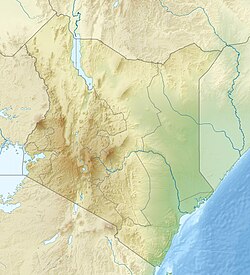Lapurr Sandstone: Difference between revisions
No edit summary |
No edit summary |
||
| Line 4: | Line 4: | ||
| caption = |
| caption = |
||
| type = [[Geological formation]] |
| type = [[Geological formation]] |
||
| age = {{fossilrange| |
| age = {{fossilrange|Campanian|Paleocene}} |
||
| period = Maastrichtian |
| period = Maastrichtian |
||
| prilithology = [[Sandstone]] |
| prilithology = [[Sandstone]] |
||
Revision as of 16:32, 8 July 2020
| Lapurr Sandstone | |
|---|---|
| Stratigraphic range: | |
| Type | Geological formation |
| Underlies | Oligocene Basalt |
| Overlies | Precambrian Metamorphic Basement |
| Thickness | 400-610 m |
| Lithology | |
| Primary | Sandstone |
| Location | |
| Coordinates | 4°18′N 35°48′E / 4.3°N 35.8°E |
| Approximate paleocoordinates | 13°48′S 27°48′E / 13.8°S 27.8°E |
| Region | Rift Valley Province |
| Country | |
| Extent | Turkana Basin, Great Rift Valley, Kenya |
| Type section | |
| Named for | Lake Turkana |
The Lapurr Sandstone, also spelled Lapur Sandstone, previously considered part of the informal "Turkana Grits", is a geological formation in Kenya. It is the oldest unit in the Turkana Basin. The strata date back to the Late Cretaceous, likely Campanian to Maastrichtian, based on palynology and the presence of dyrosaurs and mosasaurs, the upper part of the unit likely extends into the Palaeogene, based on zircon dating.[1] It predominantly consists of fine-coarse arkosic sandstone, which has been interpreted as either been deposited in fluvial or shallow marine conditions.[2][1] Dinosaur remains among other vertebrates have been recovered from it around Lokitaung Gorge, though these mostly consist of heavily abraded, isolated bones of robust morphology like sauropod limb bones and caudal vertebrae.[3][1]
Vertebrate paleofauna
| Dinosaurs and pterosaurs of the Lapurr Sandstone | ||||
|---|---|---|---|---|
| Taxa | Presence | Notes | Images | |
|
Geographically present in Rift Valley Province, Kenya. |
An unnamed titanosaur, |
||
| Sauropoda indet | Two distinct taxa | |||
| Iguanodontia indet | Two distinct taxa | |||
|
Geographically present in Rift Valley Province, Kenya.[3] |
|||
|
Geographically present in Rift Valley Province, Kenya. |
Partial cervical vertebrae | ||
|
Geographically present in Rift Valley Province, Kenya. |
An unnamed giant abelisaurid, known from partial cranial and post cranial remains. | ||
| Theropoda Indet | Large taxon | |||
See also
References
- ^ a b c Agyemang, Prince C. Owusu; Roberts, Eric M.; Downie, Bob; Sertich, Joseph J. W. (August 2019). "Sedimentary provenance and maximum depositional age analysis of the Cretaceous? Lapur and Muruanachok sandstones (Turkana Grits), Turkana Basin, Kenya". Geological Magazine. 156 (08): 1334–1356. doi:10.1017/S0016756818000663. ISSN 0016-7568.
- ^ Wescott, W.A.; Morley, C.K.; Karanja, F.M. (May 1993). "Geology of the "Turkana Grits" in the Lariu range and Mt. Porr areas, southern Lake Turkana, Northwestern Kenya". Journal of African Earth Sciences (And the Middle East). 16 (4): 425–435. doi:10.1016/0899-5362(93)90101-U.
- ^ a b c Weishampel, et al. (2004). "Dinosaur distribution" Pp. 517-607. in Weishampel, David B.; Dodson, Peter; and Osmólska, Halszka (eds.): The Dinosauria, 2nd, Berkeley: University of California Press. 861 pp. ISBN 0-520-24209-2. " Pp. 517-607.
- ^ https://etd.ohiolink.edu/pg_10?0::NO:10:P10_ACCESSION_NUM:ohiou1478778037108276
- ^ O'Connor PM, Sertich JJW, Manthi FK (2011) A pterodactyloid pterosaur from the Upper Cretaceous Lapurr sandstone, West Turkana, Kenya. Anais da Academia Brasileira de Ciências 83: 309–315.
- ^ Sertich, J., O’Connor, P., Seiffert, E. & Manthi, F. 2013. A giant abelisaurid theropod from the latest Cretaceous of Northern Turkana, Kenya. Journal of Vertebrate Paleontology, SVP Program and Abstracts Book, 2013, pp211.

